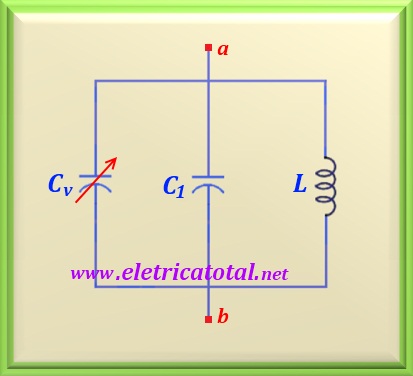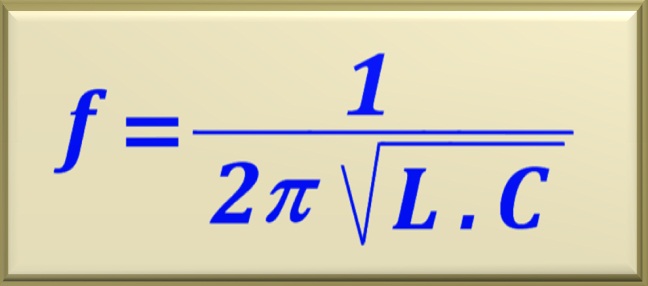Problem 56-2.
Source: Problem elaborated by the author of the site.
We wish to use an LC parallel circuit, show in Figure 56-2.1, to tune the frequencies corresponding to the
AM range, which ranges from 530 KHz to 1600 KHz. Using an inductor
of 100 µH calculate the value of a variable capacitor, which associated
in parallel with a fixed value, provides the AM band tuning.
Solution of the Problem 56-2
This circuit is known as LC parallel. The equation below defines the operating frequency when we know the values of L and C.
In this problem we know the values of L and f. So we must calculate what capacitance is required for the lowest frequency, in this case, 530 kHz. This capacitance is called
Cmax, because the higher the capacitance, the lower the resonance frequency. Thus, doing an algebraic work in the above equation:
Substituting the numerical values and performing the calculation:
Using the highest frequency (1 600 kHz), we can calculate the minimum capacitance, symbolized here by
Cmin.
Substituting the numerical values and performing the calculation:
Note that when C = 902 pF the circuit resonates at the frequency of 530 kHz.
And when C = 396 pF the circuit resonates at the frequency of 1 600 kHz.
It should be noted that a commercial variable capacitor has a minimum capacitance and a capacitance
within certain limits. In the market, there are variable capacitors that vary their capacitance between
60 pF and 600 pF. As a result, you can choose a fixed capacitor with a commercial value of
330 pF, to be placed in parallel with the variable capacitor. With this choice, we have been able to solve the required capacitance value.
Therefore, the variable capacitor must have a capacitance between the values of:
Finally, it should be noted that commercially there are variable capacitors
with minimum and maximum capacitance standardized. In order to achieve resonance
in the limit frequencies, in practice, a third adjustable capacitor, called
trimmer or padder is introduced, which through its adjustment
allows to achieve the objective.



